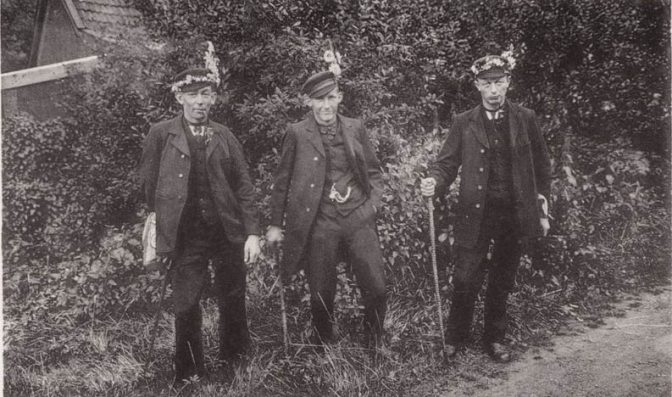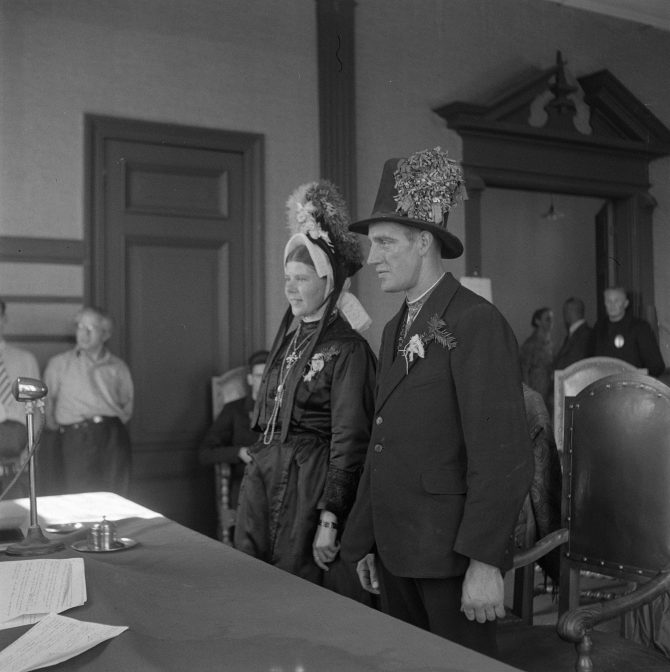A bruiloft is a wedding. Different regions have different wedding traditions, and they also changed over time.
The area of Twente in Overijssel, where I grew up, has some peculiar wedding traditions. Other regions have similar or slightly different traditions, but I thought I would share some that I experienced myself.
Even in my generation (born in the 1970s), I knew a few girls who would start their trouseau as a teenager. They started asking for plates and linens from their twelfth birthday onward, to have all the household items complete by the time they were twenty. This was a remnant of the Twente tradition that the bride came with a dowry and trouseau.
A few days before the wedding, the bride’s neighbors all get together. The men would get greens to make a ceremonial archway to the front door. The women would make white paper roses from tissues, which were attached to the arches. When the arches were done, everybody was treated to drinks, to “water” the arch. On the morning of the wedding, the groom comes knocking on her door, and escorts her through the arches, cheered on by the neighbors.
The neighbors’ involvement with the archway is a remnant of the important role that neighbors used to have in Twente society. Originally, the nearest men in the neighborhood would be the one to deliver all the invitations. The women would help with the food and the wedding.

Traditional “Brulfteneugers” [wedding inviters], 1933. Collection Gelderland, Open Cultuurdata (CC-BY-SA)
After they’re officially married, the bridal couple will be off for a photo shoot while the bridal party goes to have some coffee. The bridal couple will then rejoin them for lunch. In the afternoon, there is usually a reception, giving more distant relations a chance to congratulate the couple. This is followed by dinner with the inner circle, and then the large evening wedding, where everybody is invited. There is usually a live band, with a dance floor surrounded by tables where people sit and talk (shout, usually, to be heard over the music).
A Twente wedding is a big affair. Both extended families are invited, usually including all aunts, uncles, and first cousins, plus their partners. Also, the friends, neighbors, colleagues, business connections, and their partners. It’s rare to see a Twente wedding with fewer than 300 guests. There are different classes of guests though: closer friends and relatives are invited for the whole day, others only for the reception or for the evening.
Because of the number of guests, weddings can be expensive. Guests are often encouraged to give money rather than gifts, sometimes in the form of a not-so-subtle “envelope” icon on the wedding invitation. Most guests try to at least cover the expenses for their own participation, so a full-day guest would give more than a reception-only guest. I know couples who had anticipated to cover the cost of their wedding with the money envelopes, but who received less than they expected and were in debt for ten years after the marriage. Most people I know though, save for the wedding and then use the gift money to buy new furniture, spend it on their new house, or go on honeymoon.
The wedding cake is usually a multi-tier creation, and cut and eaten during the reception. The bride and groom cut the cake together and feed each other the first bite. Some couples put the top tier in the freezer to eat on their first anniversary for good luck.
During the evening party, friends and family members often do short sketches to honor/embarass the bride and groom. Especially groan-worthy are the A-B-C’s, where 26 traits or stories of the bride and groom are laid out for everyone to hear. “A is for the Atlas, the disco where you two met. B is for Bier [beer], which you enjoy too much.” And so on, and so on.

Twente couple in the civil ceremony, 1947. Credits: Bram Wisman, collection Nationaal Archief (CC-BY)
A good wedding provides amply for its guests. Having guests wonder where the food or drinks are is a bad omen for the bridal couple, and can be spoken about for years. At a typical Twente wedding, your glass will be filled as soon as you empty it, often even as soon as it’s more than half full. This can make it very hard to track how much you’ve had to drink. The easiest way to deal with this is to put a coaster on top of your glass, which signals to the waiters that you don’t want it refilled right now. Just take the coaster off when you’re thirsty and you should have a refill within seconds.
Towards the end of the party, the bride and groom are put on separate chairs and carried through the crowd. They’re supposed to find each other to share a kiss, but the people carrying usually take them across the room several times before that happens. Since many of the carriers are quite drunk by this time, I’ve seen brides fall from their chairs and hurt themselves. It does not help that the bride often has to choose between holding on to the chair and holding on to her dignity by making sure her hooped skirt does not provide more of a view than intended!
When the couple has found each other, it is time for them to leave, waved off by the whole party, usually with some advice for the groom on how to behave on the wedding night. When the party returns to the feast hall, there will be some food waiting for them, like warm ham on fresh bread. When the food’s gone, that’s a sign that the party is over. Usually, it’s past midnight by then. The best man and maid of honor will help the people who need more than a subtle hint. Twente weddings used to be good hunting grounds for cops trying to catch people for DUIs, but over the last couple of decades, having designated drivers or calling a taxi/friend has become the norm. I even know a couple who hired buses to bring all their family and friends home safely!
And then there’s the wedding night. Many couples spend the wedding night close by the party venue, and then leave on their honeymoon the next day. Wherever you go, make sure nobody has a key. Better yet, make sure nobody knows where you are! Or more pranks will ensue.
A classic prank is hiding alarms all over the house that start beeping shortly after the couple arrives. Other pranks I’ve heard about:
- putting toothpaste on the toilet seat, or cling foil over the bowl, under the seat.
- putting instant tomato soup or stock cubes in the shower head (I have to admit that I kind of like this one!)
- swapping the living room furniture with the bedroom furniture so the couple has to stay in the (curtainless) living room if they want an actual bed
- putting the whole house full of beer crates, where the deposit money for the crates is the wedding gift. More original than envelopes, but it prevents the couple from entering their house.
After reading this, I’m sure you’re not surprised I did not have a traditional Twente wedding myself 🙂
Many of these traditions go back to earlier times. This video shows a Twente farmers’ marriage in 1951, before most of the modernizations. It shows how the groom is picking up the bride and brings her to his house. The neighbors carry her trouseau chest from the house, and take the cow, a symbolic part of her dowry. The couple is then given drinks to celebrate their union. The whole party sits down for a simple meal. The party ends with dancing.


Nice to see the black wedding dress. I have a picture of my great-grandmother in a black dress, and I have wondered for a long time what the occasion for the picture was. I know now that it was probably her wedding picture (taken in 1910). White wedding dresses were a waste of money for working class girls.
Thank you for all this detail. My husband’s family immigrated to the US in the 1840’s from Rijessen, Overijsel. Do you think that they would have had similar wedding traditions?
Do you have a link to possible wedding traditions in rural Zeeland in the early 1900s?
I do not know of any resources for that, I’m sorry.